
About UsThe Numismatic Bibliomania Society is a non-profit organization promoting numismatic literature. For more information please see our web site at coinbooks.org SubscriptionsThose wishing to become new E-Sylum subscribers (or wishing to Unsubscribe) can go to the following web page link MembershipThere is a membership application available on the web site Membership Application To join, print the application and return it with your check to the address printed on the application. Membership is only $15 to addresses in the U.S., $20 for First Class mail, and $25 elsewhere. For those without web access, write to: David M. Sundman, Secretary/TreasurerNumismatic Bibliomania
Society AsylumFor Asylum mailing address changes and other membership questions, contact David at this email address: dsundman@LittletonCoin.com SubmissionsTo submit items for publication in The E-Sylum, just Reply to this message, or write to the Editor at this address: whomren@coinlibrary.com
BUY THE BOOK BEFORE THE COINYou won't regret it! |
- WAYNE'S WORDS: THE E-SYLUM MARCH 7, 2010
- SMITH'S AMERICAN NUMISMATIC BIOGRAPHIES AVAILABLE ON NBS WEB SITE
- SKLOW NUMISMATIC LITERATURE SALE #9 RESULTS
- NEW BOOK: NUMISMATICS OF AZERBAIJAN
- QUERY: WOODIN HOARD OF EARLY DOLLARS AND TWENTY CENT PIECES
- MORE ON CURIOUS CURRENCY BY BOB LEONARD
- THE EMERGENCY MONEY COLLECTOR, VOL. 1 NO. 1
- MORE ON COIN DESIGNS WITH MULTIPLE SETS OF DESIGNER INITIALS
- RAY WILLIAMS' NEW COIN CABINET
- PRINCETON ACQUIRES ANCIENT AND MEDIEVAL ARMENIAN COINS
- WHAT'S COPPER? WHAT'S BRONZE? WHAT'S BRASS? WHAT'S THE DIFFERENCE?
- OBAMA QUARTERS CIRCULATING IN NEW YORK
- MORE ON COINS WITH AN IMAGE OF JESUS
- HELLENISTIC COIN HOARD DISCOVERED IN NORTHERN SYRIA
- NOTES FROM E-SYLUM READERS: MARCH 7, 2010
- U.S. TREASURY TO UNVEIL NEW $100 BILL DESIGN APRIL 21, 2010
- BANK OF CANADA ANNOUNCES SWITCH TO POLYMER BANKNOTES IN 2011
- PENTAGON SHOOTER PROMOTED MARIJUANA-BASED MONETARY SYSTEM
- VEEDER'S 1885 CO-METALLIC MONEY PROPOSAL
- STOLEN MEDAL OF CZAR PETER THE GREAT RETURNED TO RUSSIA
- RESEARCHERS REUNITE PURPLE HEART CERTIFICATE WITH MEDAL
- CITIES FEEL SLIGHTED BY TRAVELLING VICTORIA CROSS MEDAL EXHIBIT
- LATEST ON THE NATIONAL GOLD EXCHANGE BANKRUPTCY
- FEATURED WEB SITE: WON PARK'S PAPER MONEY ORIGAMI
WAYNE'S WORDS: THE E-SYLUM MARCH 7, 2010

Among our new subscribers this week are Catherine Eagleton of the British Museum, and Tom Dodd. Welcome aboard! We now have 1,324 subscribers.
This week we open with word of a long-awaited update to an important numismatic reference work, and some results from David Sklow's recent numismatic literature sale.
Other topics include a hoard of early dollars and twenty-cent pieces, coin cabinets, an acquisition by Princeton University, and changes in banknotes issued by the U.S. and Canada.
You've heard of Silver Certificates and Gold Certificates, right? How about a "Gold & Silver Certificate"? Two - two precious metals in one!
To learn about the Obama quarters, beating archaeologists, a marijuana-based monetary system, and medals of rich, Corinthian Bronze, read on.
Wayne Homren
Numismatic Bibliomania Society
SMITH'S AMERICAN NUMISMATIC BIOGRAPHIES AVAILABLE ON NBS WEB SITE
American Numismatic Biographies was first published in 1992 and included about 1400 biographies. Just 100 copies were printed so it had a very limited distribution.
The current draft of (ANB has been added to the NBS website and is now available to anyone. It now includes more than 1700 biographies of people who have made an important contribution to American numismatics.
One reason for posting this is to allow any of the subjects to review their listing and offer updates or corrections. Readers may also suggest additional names for inclusion. The address to send changes is at the bottom of every page of the listing.
To access ANB, use the direct link below or
- Go to the NBS website at www.coinbooks.com
- Click on "Community Resources"
- Click on the red line anb.2010.pdf
At the top of the page is a box marked "Find" This may be used to search for any term or name. Names are in the format Last, First.
This is a work-in-progress covered by copyright protection. It may not be copied or distributed. The website will be updated periodically as the document is modified.
To view American Numismatic Biographies, see: www.coinbooks.org/resources/anb_2010.pdf
SKLOW NUMISMATIC LITERATURE SALE #9 RESULTS
 We are excited to announce that Sale # 9 that closed February 13th had the most participation of all our sales to date, more bidders, more successful bidders, more first time bidders! A hearty thank you to all bidders and consignors! Some results are listed below; please check our web site for full PRL:
We are excited to announce that Sale # 9 that closed February 13th had the most participation of all our sales to date, more bidders, more successful bidders, more first time bidders! A hearty thank you to all bidders and consignors! Some results are listed below; please check our web site for full PRL:
- Lot 10 – QDB fixed price list No. 1 - $440
- Lot 16 – American Coin Treasures Copy # 1 - $500 [the most bid lot in the sale!]
- Lot 20 – Obsolete Paper Money Copy # 1 - $500
- Lot 28 – Colonial Book that never happened - $1100
- Lot 29 – 1787 Brasher Doubloon Authenticated - $1100
- Lot 34 – Original Correspondence of H.L.P. Brand - $1100
- Lot 71 – The Cherry Picker's Guide Editing copy - $825
- Lot 93 – The Nichol's Correspondence - $1500
- Lot 114 – The Remarkable set of Spink's Numismatic Circulars - $5000
- Lot 337 – Walter Breen's copy of the Gainsborough Sale - $346
- Lot 380 – Clapp's Work on 1798-1799 large cents - $1000 [on a tie bid]
- Lot 388 – Geoffrey Adam's Auction sale June 11, 1903 - $248 [on spirited bidding]
- Lot 870 – Kagin's work on Private Gold Deluxe Leather - $459
All prices DO NOT include 15% buyers fee.
Sale # 10 Closes June 12th, 2010 and looks to be our best effort yet! Highlights are currently on our web site! If you love the California Gold Rush, you are going to love lots 1-250.
Contact: David Sklow-Fine Numismatic Books
P.O. Box 6321
Colorado Springs, CO 80934
PH (719)-302-5686
FAX (719) 302-4933
numismaticbooks@aol.com
www.finenumismaticbooks.com
NEW BOOK: NUMISMATICS OF AZERBAIJAN
The book "Basics of numismatics" by the official of the Institute of Archaeology and ethnography under the National Academy of Science of Azerbaijan Ganira Pirguliyeva, according to a source in the Institute.
The new edition speaks of the first coining and first coins in the territory of the present day Azerbaijan (3rd century B.C.), appearance of money circulation and trade turnover before mid 19th century unless Azerbaijan fell under influence of the Russian empire.
The book is bilingual in Azerbaijani and in Russian. Such a book is for the first time issued in Azerbaijani.
This is the third book of the scientist. Earlier she had released two monographs based on newest materials: "Money turnover in Azerbaijan in late 14th-early 15th centuries" and "Copper coins of Azerbaijan".
To read the complete article, see: Book on numismatics released in Azerbaijan (www.news.az/articles/10752)
THE BOOK BAZARRE
QUERY: WOODIN HOARD OF EARLY DOLLARS AND TWENTY CENT PIECES
As many E-Sylum readers know, I am a long time collector, researcher and specialist in the early U.S. Silver Dollars 1794-1803. Bob Stark, a friend and also long time specialist in the early silver dollars recently shared with me a letter "from the desk of John J. Ford, Jr." dated February 12, 1986. I was not aware of this hoard and find this information quite interesting.
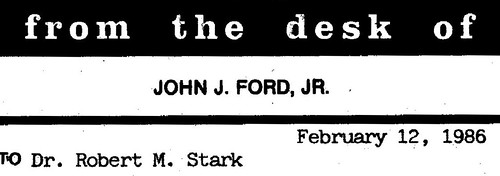
I am forwarding this for publication in E-Sylum to share this information with readers and in hope that someone might be able to shed some light on this subject. The letter reads,
"Coin World" just forwarded to me your inquiry of 1/31 regarding my mention of the hoard of 1797 U.S. silver dollars in the article on Abe Kosoff.
My article covered mainly the years prior and during WW-II. Kosoff purchased a hoard of 1797 U.S. silver dollars from the son-in-law of William H. Woodin in either late Spring or Summer of 1942, together with a large group of 1877 and 1878 Proof U.S. 20C pieces.
While I probably knew at the time, there is no way that I can tell you now what was in the group, except that I vaguely remember that it amounted to 50-75 pieces, some of which were in remarkable shape. Since almost all of Abe Kosoff's records were destroyed by his family, and because I have no idea where any records might be of Woodin's holdings, there is no place that I can suggest you go. After all, it has been forty-four years!
With my best wishes for whatever it is that you are trying to do, I am
Sincerely yours, (Signed JJ Ford, Jr.)
P.O. Drawer 706, Rockville Centre, N.Y.
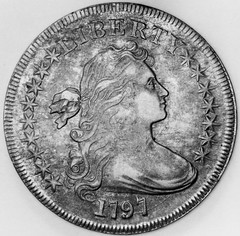
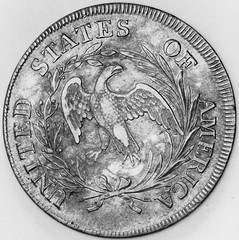
Perhaps this hoard was dispersed through one of Kosoff's public auction sales or fixed price lists. If anyone has information on this hoard, Bob and I would appreciate "solving this long time mystery." I can be reached at wdperki@attglobal.net. Thank you.
MORE ON CURIOUS CURRENCY BY BOB LEONARD
Author Bob Leonard writes:
 Thank you for the nice review of Curious Currency: The Story of Money from the Stone Age to the Internet Age. Regarding your comment that "the subtitle greatly oversells the scope of the book," I fear that you did not actually read the book, but merely thumbed through it. In fact, the first chapter (not illustrated) defines what money is, chapters two through five show the evolution of money from flint to coins, and chapter six covers money substitutes (including paper money) and our modern fiat money.
Thank you for the nice review of Curious Currency: The Story of Money from the Stone Age to the Internet Age. Regarding your comment that "the subtitle greatly oversells the scope of the book," I fear that you did not actually read the book, but merely thumbed through it. In fact, the first chapter (not illustrated) defines what money is, chapters two through five show the evolution of money from flint to coins, and chapter six covers money substitutes (including paper money) and our modern fiat money.
(I'm surprised in a way that you did not compare my: "Modern money is thus far less substantial than the money of our ancestors. Like the Holy of Holies--when you draw back the curtain, there is nothing there, just the "full faith and credit" of the issuing country." to last week's item from The Onion: "The U.S. economy ceased to function this week after unexpected existential remarks by Federal Reserve chairman Ben Bernanke shocked Americans into realizing that money is, in fact, just a meaningless and intangible social construct.")
Yes, on coins the emphasis is on "curious" ones, not the familiar machine-made round ones, and the same could be said for paper money. But the beginnings of coins and paper money are certainly included; the earliest Lydian electrum coin is illustrated (p. 101), as is the first banknote (p. 108).
As to "why another guide book to Odd and Curious currency is needed," this book is organized in a way that no other book on the subject ever has been (to the best of my knowledge). Quiggin is arranged geographically; Einzig is also arranged geographically (though with a separate historical section), and Opitz is simply an alphabetical encyclopedia.
Curious Currency shows the development of money from items of pure utility through those of increasing abstraction, up to our fiat money of today. (You have to read between the lines, though, to decide whether using pieces of printed paper for money is more "curious" than using shell beads or iron bars.)
When I started this project I knew that I had to square things with Chuck Opitz, since we needed to use his collection for most of the illustrations. He came on board willingly and caught a couple of mistakes in the text. His book, An Ethnographic Study of Primitive Money is by no means out of print, by the way, and he sells them on eBay from time to time.
On another topic, Bruce Smith is correct that the exchange rate of 40 Quattrini = 1 Paulo is unsupported. It does not agree with the values in Hazlitt's The Coinage of the European Continent or Craig's Coins of the World 1750-1850, and the difference is not due only to the phonetic spellings of the denominations.
Hazlitt (Supplement, p. 115) gives 1 Paolo usually = 8 Baiocchi. Craig has 5 Quattrini = 1 Baiocco, 30 Baiocchi = 3 Paoli (or 3 Giulio). However, if 1 Paolo = 8 Baiocchi and 1 Baiocco = 5 Quattrini, then of course 1 Paolo = 40 Quattrini. Or if "Quattrino" means 1/4 Baiocco--as would be expected--and Craig's rate of 3 Paoli = 30 Baiocchi is correct for this period, then 1 Paolo = 10 Baiocchi = 40 Quattrini.
Or there could be a misprint in the chart.
The Giulio (Julio, Jule) is "apparently so-called from the Pope Julius II," per Hazlitt (p. 203); the Paolo was introduced by Pope Paul III, 1534-59. The Ponti is not mentioned by either Hazlitt or Craig and seems to be an obsolete coin of Malta.
To read the earlier E-Sylum article, see: BOOK REVIEW: CURIOUS CURRENCY BY ROBERT D. LEONARD (www.coinbooks.org/esylum_v13n09a05.html)
THE EMERGENCY MONEY COLLECTOR, VOL. 1 NO. 1
 In the spring of 1948, a new magazine was initiated by Arlie Slabaugh called The Emergency Money Collector. It was self published and initially consisted of four sheets of 8 X 11 paper folded in half (to make eight pages) and stapled on the spine. Think about it. A self-published magazine was no trivial task before desk top computers and printers. Arlie published only seven issues of The Emergency Money Collector (TEMC). However, they're fascinating because of the knowledge and attitudes of the time. I will review the issues individually in a short series for the GRAM.
In the spring of 1948, a new magazine was initiated by Arlie Slabaugh called The Emergency Money Collector. It was self published and initially consisted of four sheets of 8 X 11 paper folded in half (to make eight pages) and stapled on the spine. Think about it. A self-published magazine was no trivial task before desk top computers and printers. Arlie published only seven issues of The Emergency Money Collector (TEMC). However, they're fascinating because of the knowledge and attitudes of the time. I will review the issues individually in a short series for the GRAM.
First, an explanation on how I got access to this little known sidebar to our hobby. Arlie died 26 Sep 07. There was an obituary and many remembrances written in The E-Sylum, the on-line magazine of the Numismatic Bibliomania Society. The editor of E-Sylum, Wayne Homren, noted he had a set of TEMC. I wrote Wayne and asked if I could read them. He said he didn't know where they were. He hadn't seen them since his last move. Well, Wayne didn't forget. Over two years later he wrote me and announced that he had found them. He sent them to me about 10 days ago and this is the result of my reading them. By the way, The E-Sylum is a very interesting electronic newsletter full of tidbits related to books and publications. You can subscribe by emailing Wayne at: whomren@gmail.com.
VOL. 1 NO.1 is the introductory issue and describes the intent of the magazine. It will be devoted to all types of emergency and necessity money (that's a new term!), to include siege coins, war monies, inflation monies of all countries, depression monies, hard times tokens, and more – all emergency issues. Subscription rates were 10 cents per copy or 25 cents per year. Advertising rates ranged from 50 per inch to $4.50 for an entire page. Advertisers could expect a guaranteed circulation of a minimum of 500 copies. Arlie also solicits input for other authors.
Ukrainian Occupation Issues: During the German occupation of the Ukraine in 1941 the following paper money was issued: 1, 5, 10, 20, 50, 100, 200, and 500 Karbowana.
There is an announcement of MPC Series 461 and 471 associated with World War I. Of course this is a typo, he means WWII. At this point in history, these were apparently the only series known to Arlie. He also lists only two series of BAFSVs.
The feature article is a two page supplement to a book Arlie had recently written on the German Inflation (1920s).
All advertising is for coins and notes from Arlie's own stocks. One is a collection of 27 German WWI coins for $3.00. Also for sale was a Spanish 5 Pesatas note dated Aug.10, 1938, that "uses a feature to prevent counterfeiting not used on other paper money". Fine condition. 75 cents. I wonder what the feature was?
Arlie Slabaugh was a trail blazer and icon of our hobby. His is one of those names that I immediately recognize when I see it, like Raymond Toy or Jimmy Swails. People I've never met, but know of their work.
Arlie Slabaugh was born 26 Apr 25 and died 26 Sep 07. He was a numismatist with many interests. He wrote extensively, usually of topics slightly out of the main stream, such as Confederate currency, tokens, the German inflation, POW issues, and Mexican Revolution coins. He published a pamphlet listing Japanese Invasion Money (JIM) in 1963
In 1941, Arlie joined the American Numismatic Association and later that year he was stricken with meningitis (in the pre-penicillin days) and subsequently became permanently deaf. This illness never stopped him (although many have stories of hard it was to understand him and communicate with him). He received the Krause Publications Ambassador Award in 1989. The ANA honored him with their Lifetime Achievement Award in 2004, the Medal of Merit in 1991, the Glenn Smedley Award in 1997 and the President's Award in 1997. In 1981, he received the coveted Numismatic Literary Guild Clemy Award.
MORE ON COIN DESIGNS WITH MULTIPLE SETS OF DESIGNER INITIALS
In connection with the Los Angeles Olympic Games (see historical and legislative commentary under 1983 Olympic silver dollars), gold coins bearing a legal face value of $10 were issued at four mints using the same alloy and specifications as employed for United States $10 issues circa 1838-1933, the first commemorative gold coins to be struck since the 1926 Sesquicentennial $2.50 gold pieces.
The obverse design was modeled at the Philadelphia Mint by staff engraver John Mercanti after a sketch by James M. (Jim) Peed of the Bureau of the Mint's Washington office. Depicted were male and female runners ("Dick and Jane," according to the facetious remarks of some observers including Rep. Frank Annunzio) holding a torch.
Both JM and JP initials appear at the lower left, an unusual double signature, which resulted from a conversation which Mint Director Donna Pope had with the present writer. At the time I was president of the American Numismatic Association (for the 1983-1985 term), and Mrs. Pope maintained an excellent relationship and continuing dialogue not only with the ANA but with numismatic publications and the entire collecting fraternity.
She inquired whether it was accepted practice to include the initials of the designer as well as the engraver, and I cited several examples from history, after which she decided to employ it on the 1984 Olympic gold coins.1 Mrs. Pope feared criticism if she were to defy convention by using a double set of initials, for certain individuals in the government stood ready to find fault with just about anything the Mint tried to do.
The reverse of the 1984 $10 gold coin by John Mercanti illustrated a heraldic eagle adapted from the Great Seal of the United States, a motif similar to that used on numerous regular issue coins from the 1790s onward (most recently on the Kennedy half dollar from 1964 to date).
To read the complete article, see: MORE ON COIN AND MEDAL DESIGNS WITH TWO SETS OF DESIGNER INITIALS (www.coinbooks.org/esylum_v13n09a15.html)
RAY WILLIAMS' NEW COIN CABINET
Well, the fine art of making coin cabinets hasn't completely died out. E-Sylum reader Ray Williams forwarded some pictures of his new cabinet, made for him by Craig McDonald. -Editor
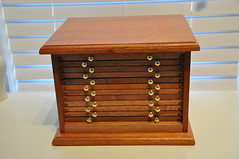


Ray Williams writes:
The cabinet is so beautiful - I wish I could store my main collection in it. But alas, they must stay in a safe deposit box. But when I have a friend over to look at coins, I can arrange them in these drawers and have an attractive presentation. Plus I can store less expensive coins here too.
This cabinet reminds me of how collectors stored coins in the old days. I would imagine that one of the reasons that colonial coins had their attributions written in white ink on the coin surface was for easy identification in a tray (plus if the tray was dropped....
Craig McDonald has used old-fashioned hand craftsmanship to make something this beautiful to enhance the enjoyment of my hobby.
PRINCETON ACQUIRES ANCIENT AND MEDIEVAL ARMENIAN COINS
The Princeton University Numismatic Collection has acquired the Armenian Heritage Collection of ancient and medieval coins, adding a new area of specialized strength to the University's extensive numismatic research holdings.
The Armenian Heritage Collection was assembled over a period of decades by an expert collector, who sought to represent the various periods in the pre-modern age when Armenia produced its own coinage or made substantial contributions to the coinage of other powers, according to Princeton Curator of Numismatics Alan Stahl.
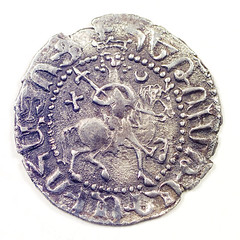

Cilician Armenia, Hetoum I, bilingual silver tram, also acknowledging Kaikhusraw, Sultan of Konya, dated AH 644 (AD 1246-47).
"The collection includes coins of three distinct periods, all of interest to the academic concerns of the University," Stahl said.
Stahl said the acquisition will provide scholars with access to significant materials to study early Armenian civilization, as well as provide new opportunities at Princeton to research ancient and medieval societies.
The earliest coins in the collection are those of the Artaxiad dynasty, which became the largest political power east of Rome in the first century B.C. The coins of most relevance to Princeton's existing holdings are those minted in the reign of Tigranes the Great, who ruled from the Seleucid capital of Antioch-on-the-Orontes from 95 to 55 B.C.
"The coins of Tigranes from Antioch hold special interest for Princeton because University scholars led the excavations of the site in the 20th century and the University holds more than 30,000 coins found there in our collection," Stahl said. "One of the great mysteries of the coins from these excavations is the lack of any in the name of Tigranes and the dearth of local municipal coins for the period of his reign."
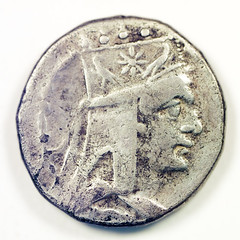
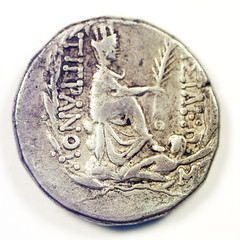
Armenia, Tigranes the Great, silver tetradrachm of Antioch, 83-69 BC. The star on his crown is believed to represent Halley's comet, which was visible in Armenia in 87 BC
Included in the collection are two large silver pieces of Tigranes the Great and 19 bronze coins in his name, as well as examples of rare coins featuring his successors. All of these coins follow the models of the Hellenistic world, with the portrait of the ruler on the front of the coin and a local deity on the back. The writing on the coins is in Greek.
"The acquisition of this interesting and uncommon collection will significantly broaden Princeton's resources for the study of both the history and the imagery of the classical world," said Michael Koortbojian, Princeton professor of art and archaeology. "Moreover, this new collection will not only allow students and faculty direct access to primary historical material, but, in the context of Princeton's broader numismatic holdings, it will provide an important body of material for research into the interactions between the various cultures and societies that comprised the ancient and medieval world."
The second group of coins in the Armenian Heritage Collection comprises gold solidi of the Byzantine Empire from the sixth through the 11th century.
"Armenians figured prominently in the government of Byzantium, including in the ranks of its important emperors. The addition of these magnificent gold solidi greatly strengthens our holdings of Byzantine coinage, which has constituted a major focus of acquisition in recent years," Stahl said.
The third component of the collection comprises coins of the medieval kingdom of Cilician Armenia, on the south coast of what is now Turkey. The kingdom, ruled by Roupenid family, had strong ties to its surrounding powers, Byzantine, Islamic and Crusader. These connections are illustrated by a large silver coin in the collection, equivalent to the European groat or the Islamic dirhem. The coin bears on its front an image of the king on horseback in European style, surrounded by a legend in Armenian characters, while on the back it bears writing in Arabic.
"The coins of Cilician Armenia in the new collection complement the Latin Orient Collection of Crusader Coinage that we acquired two years ago, giving us a fuller picture of the interplay of coinages in the medieval eastern Mediterranean," Stahl said.
The Armenian Heritage Collection was acquired by the Princeton University Numismatic Collection with funds from the Friends of Princeton University Library and matching funds provided by the University's Program in Hellenic Studies with the support of the Stanley J. Seeger Hellenic Fund. The Numismatic Collection is part of the Department of Rare Books and Special Collections in Princeton University's Firestone Library.
For more information on the Princeton University Numismatic Collection, see: www.princeton.edu/~rbsc/department/numismatics/ (http://www.princeton.edu/~rbsc/department/numismatics/)
THE BOOK BAZARRE
WHAT'S COPPER? WHAT'S BRONZE? WHAT'S BRASS? WHAT'S THE DIFFERENCE?
Medal researcher Ron Abler wrote me this week about a problem he is facing identifying the composition of medals in the American centennial period he is cataloging.
"Speaking of alloys," he writes, "one of the problems that I'm grappling with is proper identification and designation of bronze, copper and brass medals. It seems that 19th century catalogers were not very precise in their use of these terms. In fact, if one were to cross Holland's list with Frossard's list and contemporary auction descriptions (as I have done), one might draw the conclusion that copper medals should be more prevalent than they appear to be today."
Ron is attempting to be precise in his catalog descriptions, for which he should be greatly admired. He noted that 130 years of toning of his 1876 medals further amplifies the problem. Correct. Copper and all copper-based alloys tone in time. Nature of the beast.
Copper is a popular coinage metal because of its (somewhat) low cost and high coinability. It has been used for coins since 450 BC. And as every Lincoln cent collector knows, untarnished copper red quickly turns brown in circulation.
I checked my entry on Bronze in my Encyclopedia of Coin and Medal Technology and found 26 names of bronze alloys that have been used as the composition for coins and medals. It is all a matter of the amount of zinc (generally) alloyed with copper. While copper is the major component it is alloyed with zinc and/or tin with other metals as trace or impurities.
Even nickel-silver is on this list. It is a copper alloy (as much as 72 percent) despite the fact it bears a compound name of two other coinage metals. It has no silver, but does have nickel (up to 18 percent).
As Ron Abler observed it is difficult to determine an EXACT composition because these alloys have a wide range of copper-alloy formulations. There is one clue: color. A copper-zinc alloy remains red in just-struck or as-cast state until the zinc reaches 15 percent (with 85 percent copper). From 85 to 72 percent copper the alloy is brass and has the typical brass yellow color. Below 72 percent copper the color becomes gray like copper-nickel (or silver-nickel).
By inspection alone any other determination is impossible. Ron considered doing specific gravity tests but learned these test results are so close to be inconclusive. Yes, other laboratory tests could be conducted, but is it that important to learn a few percentage points of zinc one way or the other?
Most mints or medal makers order their strip stock in whatever is required or most convenient. Thus the amount of zinc is not always that precise.
He mentioned that three coin dealers suggested calling the composition "bronze" and let it go at that. I concur. I would like to know more about the artist, the design, the reason for the item's issue and other historical factors rather than the exact amount of zinc in the item's composition.
With that in mind I must relate one incident about "bronze." In 1913 coin dealer Thomas Elder wanted to issue a series of plaques of famous people. He contracted with sculptor Jeno Jusko to model 13-inch plaques, which he would issue that size (and two smaller size reductions). When he began writing his sales pitch he felt the word "bronze" did not have enough éclat. Promoter that he was he stated that all his plaques would be cast in "Corinthian Bronze."
Corinthian Bronze? I refuse to make that the 27th term in my list of bronze names!
OBAMA QUARTERS CIRCULATING IN NEW YORK
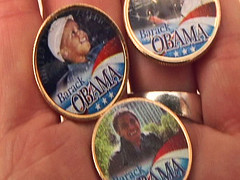 They don't look like regular quarters. The small discs actually look fake.
They don't look like regular quarters. The small discs actually look fake.
"These are the new Obama quarters," explained the clerk at a Yonkers UPS store as she handed over change.
Huh? Doesn't it take an act of Congress to put a person on coin or currency and doesn't that person have to be deceased?
The Obama quarters are gold plated and bear a picture -- baby pictures, in some cases -- of the 44th president on one side. Regular quarters are engraved with the face of George Washington and made of copper and nickel.
In the case of the Obama quarter, a decal of Barack covers the engraving of George. Nonetheless, the store clerk insisted the Obamized 25-cent pieces were authentic because she got them from the Webster Bank a few blocks away.
Branch manager David Delgado said customers deposited the coins and the bank recirculated them to other customers.
"These are real coins turned into novelty items, "said Ed Steadham, a Webster Bank spokesman.
But is an altered coin still currency? As long as you're not trying to cheat anybody with one and it's accepted by the other party, it is, according to Michael White of the U.S. Mint.
Dubious, we tested it out. But when we bought a soda from a Manhattan street vendor using one of the coins, we were surprised by his lack of curiosity.
"This is the second time I've seen one," said Alberto Delacruz.
To read the complete article, see: Is the Obama Quarter for Real? (www.nbcnewyork.com/news/local-beat/Obama-Quarters-Loose-Change-85821077.html)
MORE ON COINS WITH AN IMAGE OF JESUS
Justinian II summoned a Ecumenical Council in 692 in Trullo whose Decrees and Canons were never signed by Sergius, the Pope. Justinian went so far as to attempt kidnapping Sergius to obtain his signature, nevertheless, Justinian proceeded as if they were in effect.
Canon LXXXII states in part "In order therefore that 'that which is perfect' may be delineated to the eyes of all, at least in coloured expression, we decree that the figure in human form of the Lamb who taketh away the sin of the world, Christ our God, be henceforth exhibited in images, instead of the ancient lamb, so that all may understand by means of it the depths of the humiliation of the Word of God, and that we may recall to our memory his conversation in the flesh, his passion and salutary death, and his redemption which was wrought for the whole world."
The ancient Epitome is succinct: "Thou shalt not paint a lamb for the type of Christ, but himself." As a result, Justinian's coinage is the first Byzantine coinage to portray Christ.
I've attached images of this coin, Christ is on the obverse, Justinian on the reverse. The December 6, 2009 E-Sylum (v12n49) had inspired me to look into the coin and I found one in an auction in Frankfurt.
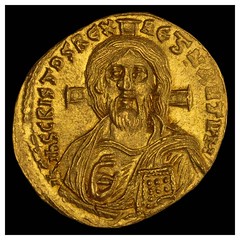
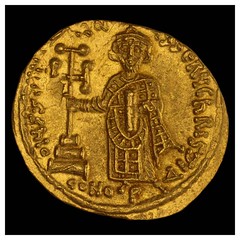
A 1959 monograph by James Breckenridge, "The Numismatic Iconography of Justinian II" in Numismatic Notes and Monographs, New York, American Numismatic Society, draws the startling conclusion that the portrait of Christ is derived from a statue of Zeus at Olympia by the Greek sculptor Phidias, one of the Seven Wonders of the Ancient World. This image appears to have become one of the traditional images of Christ. en.wikipedia.org/wiki/File:Christus_Ravenna_Mosaic.jpg
 The Phidias statue has been lost, but a bust in the Museum of Fine Arts in Boston is believed to be a close copy, an image of that is attached. If one scales the coin image and bust similarly in a computer image program, then overlays the two, one with transparency, the similarity is clear. Religious art was Breckenridge's field and his eye likely did this immediately.
The Phidias statue has been lost, but a bust in the Museum of Fine Arts in Boston is believed to be a close copy, an image of that is attached. If one scales the coin image and bust similarly in a computer image program, then overlays the two, one with transparency, the similarity is clear. Religious art was Breckenridge's field and his eye likely did this immediately.
I've thought the last several years that one cannot underestimate Plato's influence on Christianity, however, I hadn't realized the extent of the ancient Greek iconographic influence until recently, although this coin of Philip II had me wondering a few years back: www.ancientmoney.org/greek_kingdoms/philipii_tetradrachm.html
To read the earlier E-Sylum article, see: PRINCETON ACQUIRES 7TH CENTURY COIN WITH AN IMAGE OF JESUS (www.coinbooks.org/esylum_v12n49a15.html)
HELLENISTIC COIN HOARD DISCOVERED IN NORTHERN SYRIA
 The coins were found by a local man as he was preparing his land for construction, uncovering a bronze box that contained around 250 coins. He promptly delivered the coins to the authorities who in turn delivered them to Aleppo Department of Archaeology and Museum.
The coins were found by a local man as he was preparing his land for construction, uncovering a bronze box that contained around 250 coins. He promptly delivered the coins to the authorities who in turn delivered them to Aleppo Department of Archaeology and Museum.
Director of archaeological excavations at Aleppo Department of Archaeology and Museum Yousef Kanjo said the box contained two groups of silver Hellenistic coins: 137 tetra drachma (four drachmas) coins and 115 drachma coins.
One side of the tetra drachma coins depicts Alexander the Great, while the other side depicts the Greek god Zeus sitting on a throne with an eagle on his outstretched right arm. 34 of these coins bear the inscription "King Alexander" in Greek, while 81 coins bear the inscription "Alexander" and 22 coins bear "King Phillip."
The drachma coins bear the same images as the tetra drachma, with "Alexander" inscribed on 100 of them and "Philip" on 15 of them.
To read the complete article, see:
Archaeological Findings: Hellenistic Coins Discovered in Northern Syria
(www.english.globalarabnetwork.com/201003025027
/Travel/archaeological-findings-hellenistic-coins-discovered-in-northern-syria.html)
NOTES FROM E-SYLUM READERS: MARCH 7, 2010
Kay O. Freeman writes:
Regarding my ham-handed introduction to Joel Orosz and Len Augsburger's announcement of their viewing of an archive of Eckfeldt family artifacts, Bill Eckberg writes:
I am very much looking forward to their book - and their talk after Dave Bowers' at the Early American Coppers convention next month (in Annapolis, VA)
Arthur Shippee writes:
David Meadows noted this very interesting blog post about Harlan Berk.
Berk said he was told an archaeologist told a school teacher it was a bad thing to give ancient coins to children. Speaking at the NYINC meeting Berk said, "I am angry at the archaeologists and I want to beat them."
To read the complete article, see: "I am angry at the archaeologists and I want to beat them" (lootingmatters.blogspot.com/2010/03/i-am-angry-at-archaeologists-and-i-want.html)
THE BOOK BAZARRE
U.S. TREASURY TO UNVEIL NEW $100 BILL DESIGN APRIL 21, 2010
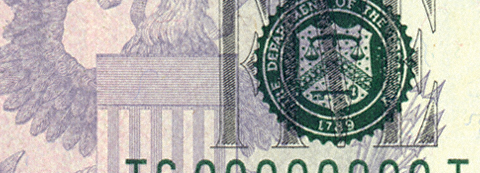
Aiming to stay a step ahead of counterfeiters, the government is planning a new design for the $100 bill that will be unveiled next month, the Treasury Department said Friday.
Wraps will come off the facelift for Ben Franklin at an April 21 ceremony in the ornate Cash Room at the department, the site of Ulysses Grant's first inaugural ball in 1869. Treasury Secretary Timothy Geithner and Federal Reserve Chairman Ben Bernanke will do the honors.
The government says its decisions on redesigning currency are guided by assessments of counterfeiting threats, from digital technology or old-fashioned printing presses.
The unveiling of the new design is the first step in a global campaign by the Treasury Department, the Federal Reserve Board and the Secret Service to inform users of the bill of the changes before it starts circulating, Treasury said in a news release.
Training materials on the new $100 bill for those who handle cash and educational information will be available in 25 languages beginning on April 21 at http://www.newmoney.gov.
To read the complete article, see: New $100: Ben's facelift to be revealed (www.google.com/hostednews/ap/article/ALeqM5jN7QgltvpmdZ-z9KUJXYc14EqHbQD9E8JHE00)
NOTE: The web address newmoney.gov has since changed to uscurrency.gov . -Editor
BANK OF CANADA ANNOUNCES SWITCH TO POLYMER BANKNOTES IN 2011
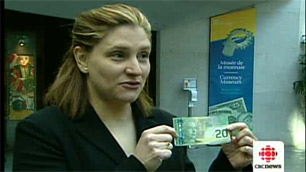 They say money doesn't grow on trees. Well, the federal government has taken that adage to heart — it announced earlier this week that Canada's paper-cotton banknotes would be replaced by newly designed plastic ones next year.
They say money doesn't grow on trees. Well, the federal government has taken that adage to heart — it announced earlier this week that Canada's paper-cotton banknotes would be replaced by newly designed plastic ones next year.
It's part of a plan to modernize and protect Canadian currency against counterfeiting.
The new plastic bills, made from a polymer material, are harder to fake, recyclable, and two to three times more resistant to tearing, the Bank of Canada said.
Australia has used polymer banknotes since the 1990s, and an Australian company will provide the material for Canada. Several other countries have adopted polymer banknotes including New Zealand, Vietnam and Romania.
The new notes won't be in circulation until sometime in 2011. In the meantime, the central bank is keeping mum on what the new bills will look like.
To read the complete article, see: Canada to switch to plastic bills next year (www.cbc.ca/money/story/2010/03/06/ott-plastic-money.html)
One citizen responding on another web site wrote:
NO! NO! NO! NO! What a tragedy! I've used the Australian plastic notes and they are horrible! They're slick and slippery and 'fly' out of your wallet. If you use a billfold you'll hate them even more: you cannot put a crease or fold on the bill at all. I am so sad. I've been deriding and laughing at the Australian "monopoly" money for years now and now it's coming home to roost. I really wish the BoC had done it's due diligence first.
To read the complete comment, see:
Canada to move to Polymer Bank Notes
(netnewsledger.com/index.php?option=com_content&view
=article&id=1654:canada-to-move-to-polymer-bank-notes&catid=35:
northwestern-ontario-regional-news&Itemid=83)
PENTAGON SHOOTER PROMOTED MARIJUANA-BASED MONETARY SYSTEM
Loren Gatch writes:
I don't mean to make light of a tragedy like the recent Pentagon shooting, but I would point out one aspect of John Patrick Bedell's bizarre agenda was advocacy of a "marijuana-based monetary system". The following excerpt comes from Gawker.com:
Here is Bedell, also with no real emotion on his face, as he explains in a Youtube video his complex system of "information currency," which appears to have been one of his obsessions:
Bedell was clearly intelligent; he was an avid software developer and aspiring engineer who worked to develop technology he believed would lead to "liberty and justice". He was nonetheless a certifiable wackjob. Steve Huff at mediaelites has posted a summary of what can be gleaned from Bedell's Internet activity. Bedell, who had a bachelor's degree in physics from the University of California, Santa Cruz, believed the government was behind 9/11, and these beliefs interfaced strangely with an enthusiasm for marijuana legalization and the "Information Currency" system he explains above.
Speaking of the suicide of Marine Col. James Sabow—whom conspiracy theorists believe was assassinated by the government to cover up a 9/11 plot—Bedell wrote on his Wikipedia profile (now deleted):
I am determined to see that justice is served in the death of Colonel James Sabow, as a step toward establishing the truth of events such as the September 11 demolitions and institutions such as the coup regime of 1963 that maintains itself in power through the global drug trade, financial corruption, and murder, among other crimes.
Bedell claims these beliefs led him to attempt to devise a subversive marijuana-based monetary system based on his ideas of Information Currency. He started with a 16-plant growing operation on his balcony in Irving, CA.
To read the complete article, see: In Video, Audio and Writing, Pentagon Shooter Left Bizarre Internet Trail (gawker.com/5486333/in-video-audio-and-writing-pentagon-shooter-left-bizarre-internet-trail)
VEEDER'S 1885 CO-METALLIC MONEY PROPOSAL
The U.S. Mint has experimented at times with some interesting blends of metals. For instance, in the late 1870s patterns were minted in "goloid"—a combination of gold, silver and copper it was argued would provide the solution to the then raging battle over the monetary standard.
Knowing this, I was intrigued by an 1885 proposal I ran into by Nicholas Veeder describing a new coin and paper money system he envisioned called "cometallism." In a lengthy paper, titled Cometallism: Gold and Silver Coinage, Uniting and Blending their Values in Paper Money, and for Establishing a Composite Single Standard Dollar of Account, written after the beginning of the Free Silver agitation and during the period of falling silver values, Veeder looked to address the problem of a lower value metal driving the higher value metal from circulation and the complaints associated with a depreciated currency.
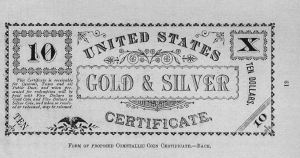
[Veeder] called for the issuance of "coin certificates" (a $10 note is shown here), "which could be made payable in cometallic coin, or in separate gold and silver coins or bars, constituting an equal number of dollars of each metal..." "Such coin certificates," he added, "would be the most perfect money possible for use as general currency, as they would be issued only against a specific deposit always held in readiness for specific redemption, and would, therefore, in all probability be redeemed, even if, for some now unforeseen reason, the payment of specie for greenbacks and bank notes should be suspended."
There's much more to Veeder's plan, 67 pages in all, including the definition of a new "Dollar of Account" (linked to his cometallic coin), and specifications for the coin certificates. His cometallic coin would be called a "dollar," a gold coin issued not in cometallic form would an "orum," a silver coin not in cometallic form an "argent" and a paper dollar a "greenback."
To read the complete NumisMaster article, see: Certificates Part of 'Cometallic' Proposal (www.numismaster.com/ta/numis/Article.jsp?ad=article&ArticleId=9667)
STOLEN MEDAL OF CZAR PETER THE GREAT RETURNED TO RUSSIA
 The U.S. Ambassador to Russia returned a stolen silver medallion that belonged to the last Russian czar to Moscow Thursday after it was recovered from an online auction by U.S. investigators.
The U.S. Ambassador to Russia returned a stolen silver medallion that belonged to the last Russian czar to Moscow Thursday after it was recovered from an online auction by U.S. investigators.
Ambassador John Beyrle said that the recovery of the rare artifact signaled increasing trust between Moscow and Washington.
"This detective story is a wonderful example of successful cooperation, which allows us to improve relations between Russia and the United States," Beyrle said during a ceremony at his official residence.
The medallion, which bears a portrait of Czar Peter the Great, once belonged to the family of Russia's last Czar, Nicholas II. It was stolen from the State Hermitage museum in St. Petersburg.
To read the complete article, see: United States Gives Russia Back Czar's Stolen Medallion (www.artdaily.org/index.asp?int_sec=2&int_new=36640)
RESEARCHERS REUNITE PURPLE HEART CERTIFICATE WITH MEDAL
 On an ordinary Saturday in January, volunteers at the Salvation Army in Upstate New York were sifting through donations of unwanted stuff when Shelia Gladding opened a box of what looked to be the usual chipped glass trinkets and forlorn bric-a-brac.
On an ordinary Saturday in January, volunteers at the Salvation Army in Upstate New York were sifting through donations of unwanted stuff when Shelia Gladding opened a box of what looked to be the usual chipped glass trinkets and forlorn bric-a-brac.
Then she scooped out a piece of paper. "Purple Heart," it read. "For military merit and for wounds received in action resulting in his death June 6, 1944."
D-Day.
Next to it, she found a sepia-tinted photograph of a smiling, handsome blond man in uniform, the Purple Heart recipient, Sgt. Richard E. Owen. On the back of the picture was a 15-cent stamp and the address of a Mrs. Richard E. Owen in Winchester, Va.
Gladding froze. How could this be? The official recognition of the ultimate sacrifice a soldier can make to his country, tossed in a box of discarded household items?
"It wasn't even wrapped neatly in paper," Gladding said. "I thought of my father, who fought in World War II, and how upset he'd be if he had a Purple Heart and his certificate wound up like this one, in a box of junk."
Heimbrock embarked on a search that would soon span the country as amateur genealogists, military bloggers, veterans groups, journalists and well-wishers transfixed by the mystery rummaged through courthouse records in Indiana, pored over newspaper archives in Pennsylvania, paged through old city directories in Winchester, surfed every corner of the Web and cold-called every Owen in dozens of phone books in a desperate attempt to find his next of kin.
"I am consumed by the story," a military blogger wrote last week. "I refuse to believe that this hero goes unremembered."
To read the complete article, see: The story of a Purple heart citation and a search for the medal's owners (www.washingtonpost.com/wp-dyn/content/article/2010/03/05/AR2010030504284.html)
CITIES FEEL SLIGHTED BY TRAVELLING VICTORIA CROSS MEDAL EXHIBIT
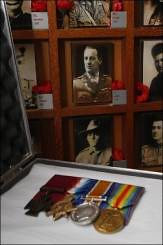 LANE Cove MP Anthony Roberts has accused the State Government of being "asleep at the wheel" after Sydney missed out on the rare opportunity to host a touring exhibition of Victoria Cross medals.
LANE Cove MP Anthony Roberts has accused the State Government of being "asleep at the wheel" after Sydney missed out on the rare opportunity to host a touring exhibition of Victoria Cross medals.
He said the medals - a permanent fixture at the Australian War Memorial in Canberra - were being displayed around the country but NSW and Tasmania had missed out.
"It's important that we recognise and pay tribute to individuals who took this heroic action," he said.
The exhibition will be taken on a 10-month tour while the Australian War Memorial's Hall of Valour is being refurbished.
Mr Roberts said many people - particularly large families - were unable to drive to Canberra for the day, others could not afford it or were physically unable to get there.
To read the complete article, see:
VC medal tour omits Sydney: Roberts irate
(north-shore-times.whereilive.com.au/news/story
/vc-medal-tour-omits-sydney-roberts-irate/)
LATEST ON THE NATIONAL GOLD EXCHANGE BANKRUPTCY
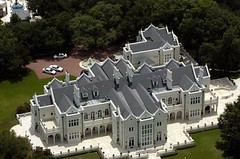 Mark Yaffe, a Tampa businessman who became one of America's leading gold coin dealers, will see much of his gold empire dismantled after a bankruptcy judge's decision today.
Mark Yaffe, a Tampa businessman who became one of America's leading gold coin dealers, will see much of his gold empire dismantled after a bankruptcy judge's decision today.
National Gold's chief creditor, Sovereign Bank, already had seized most of the company's assets months ago, but was prevented from selling them off when National Gold filed for bankruptcy protection last summer.
Those assets include millions of dollars in gold and rare coins and Yaffe's collection of antique music boxes, which are similar to player pianos.
Now, with the judge's order, the bank is authorized to liquidate the items. Richard McIntyre, National Gold's bankruptcy attorney, expects the music boxes could sell for at least $7 million, while the coins should sell for more than $5 million.
Meantime, Yaffe is trying to sell off his opulent mansion in Tampa's Avila community to pay off his creditors. The 29,000-square-foot residence is stocked with the music boxes.
Despite his company's liquidation, Yaffe expects to continue in the gold coin business, McIntyre said.
He has recently received loans from his father and others allowing him to launch a new, if much smaller, coin operation called Phoenix Gold, McIntyre said.
To read the complete article, see: Gold dealer Yaffe will see empire liquidated by court (www2.tbo.com/content/2010/mar/03/gold-dealer-yaffe-will-see-empire-liquidated/)
FEATURED WEB SITE: WON PARK'S PAPER MONEY ORIGAMI
This week's Featured Web site is suggested by Dave Bowers.
Origami is the traditional Japanese art of paper folding. The goal of this art is to create a representation of an object using geometric folds and crease patterns preferably without the use of gluing or cutting the paper, and using only one piece of paper.
Won Park is the master of Origami. He is also called the "money folder", a practitioner of origami whose canvas is the United States One Dollar Bill. Bending, twisting, and folding, Won Park creates life-like shapes inspired by objects living and not– both in stunning detail.
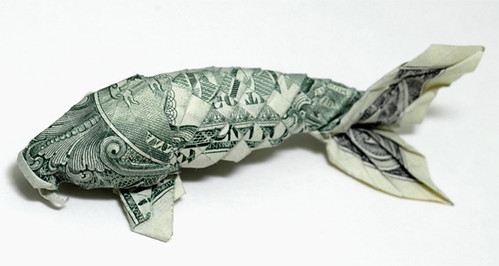

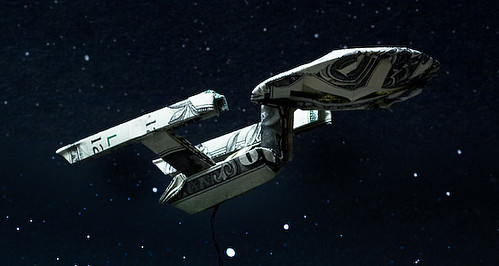
thedesigninspiration.com/articles/won-park
-the-master-of-origami-paper-folding/
